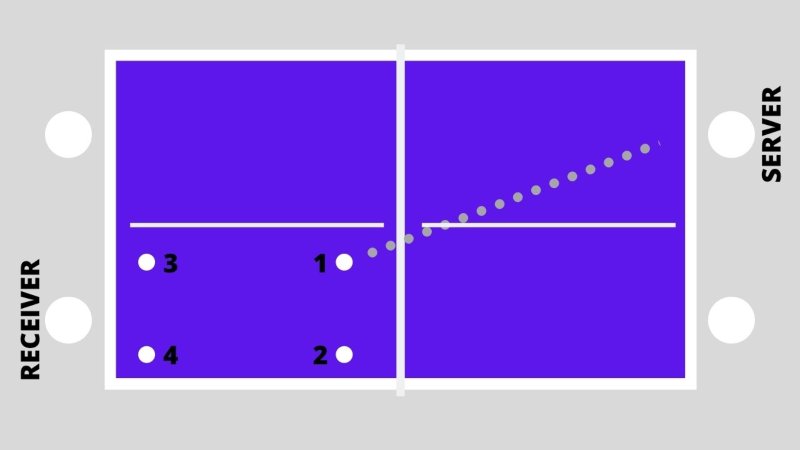
What are the best serves to do when playing doubles matches? This topic isn’t discussed very often, but it does come up occasionally in my coaching sessions.
A few players I coach play a lot of doubles. These are usually older players, who are part of community groups, with a few tables, but lots of participants. To give everyone an opportunity to play, they mostly organise doubles matches. And in amateur leagues and tournaments, there is usually an opportunity to play doubles matches too.
So serving in doubles is something we have all experienced, but probably not given as much thought to as our singles service game. I don’t confess to having all the answers, but in this article I give a few thoughts on effective serves to do when playing doubles, focusing on placement, spin variations and forehand vs backhand serves. Let’s jump in…
Service placement
When serving in doubles, you are more limited in your placement options. You can only serve to one half of the table. Your opponent knows the serve will come cross-court and can prepare for this. This makes it much harder to surprise your opponent with an unexpected ball placement compared to singles, where you have the full table to use.
However, you can still be clever with your ball placement, to make it more challenging for your opponent. There are four main areas which I like to serve to, as shown in this diagram. Let me briefly talk about the pros and cons of each position.

- Short to the middle – This is a service position I will use often, especially if my opponent is a strong attacker. I would consider this a ‘containing’ ball placement. I’m trying to make it hard for my opponent to attack and reduce the extreme angles he can return the ball. I am expecting him to be able to return the serve, but hopefully in a more passive way, which gives my partner an opportunity to play a decent shot.
- Short and wide – I will use this position if I sense my opponent doesn’t move very well. If I can get the serve close to the side of the table, moving outwards, then my opponent will need to move and then play a shot. If my opponent doesn’t move and just stretches out to return the serve, it will likely be a weak return which my partner can take advantage of. But there is risk with this service placement. If my opponent does move, then he may be able to return it at a very wide angle, making it tough for my partner.
- Long to the middle – I often use this serve as a surprise option, especially if I have already served a few short. The idea is to get both depth and speed – the change of pace can catch an opponent out and force an error or a weak return. The placement to the middle line can cause difficulty. I’m not sure exactly why. Maybe it’s a service position which players are simply less used to. Or maybe it’s a position which makes an opponent stretch (if receiving with a backhand) or jams him up (if receiving with a forehand). Either way it seems to work. The biggest risk with this serve is that you serve on the wrong side of the table and lose the point!
- Long to the corner – This is a good placement, if you sense your opponent struggles with long serves. Again the aim is to use both depth and speed to force your opponent into an error or to make a weak return. This is a riskier serve if your opponent is a strong attacker who is not troubled by a long fast serve. It may get whacked back and your partner won’t be too happy with you.
When I’m playing doubles, I will mostly serve short to the middle, with the occasional long fast serve, usually aimed at the middle of the table. However, if I sense my opponent does not move well or struggles with long spinny serves, then I’ll go wide and long a bit more often.
Service spin
When serving in doubles, backspin is probably the safest option. If you can get a good amount of backspin it makes it much harder for your opponent to play a strong attacking shot. This then gives your own playing partner a decent chance of playing the next shot.
However, a strong backspin serve may not give you any particular advantage in a rally. You have made it hard for your opponent to attack, but it’s a fairly easy serve to return and your opponent can also make it hard for your partner to attack. A backspin serve is a safe option – a way of containing your opponent – but not a serve which is likely to set up an weak ball for your partner.
So I find it useful to vary the spin of my serves. I still probably serve backspin 50%-70% of the time, but I will also mix in some float serves, some sidespin serves and some topspin serves. You also need to consider your partner. Some partners will be great at playing fast topspin rallies, so you have a little more scope for using sidespin and topspin serves. Other partners struggle with the pace of fast rallies, so using topspin serves may put you at a big disadvantage.
The partner I have played doubles with the most (my teammate Yordan), is very good when the rallies start as backspin. He can push very well and he can block aggressively if someone loops or flicks my backspin serve. So when I play with Yordan, I may do 75% backspin serves as this sets up the type of rally which Yordan wants. For another doubles partner it may be completely different. It’s a good idea to check with your partner what type of rally they prefer.
Forehand or backhand serves?
If you are right handed, serving in doubles is a little more complex. In singles we usually serve with our forehand from the backhand corner of the table – and very often we serve cross-court to our opponent’s backhand. But in doubles it’s the opposite. We have to serve from the forehand side cross-court to our opponent’s forehand side. This can make serving with your forehand a little awkward.
Because of this, I will often serve with my backhand. This feels a more natural position for doubles. It allows me to hit all four target areas (as shown above) and vary the spin between backspin, no spin, sidespin and topspin. As I am standing more in the corner, it means my doubles partner can take a more central position, which makes it easier for him to deal with any ball which comes back after the serve.
However, this is just my personal preference. Sometimes I will switch to forehand serves, if I feel my backhand serves aren’t proving effective or if I want to mix things up a bit. And if my partner is left handed, I will usually use forehand serves, so that I am not in his way.
There is no right or wrong. If your forehand serves are much stronger than your backhand serves, it makes much more sense to use your forehand serves. But if you can develop some decent backhand serves, you may find these easier to use.
And if you are left handed – well, lucky you! You can take the same service position as singles matches!
Final thoughts
I don’t think I have all the answers. But hopefully I have given you something to think about.
The takeaway message from me is that serving in doubles is different to singles. You need a different strategy. You are more limited in your options. And you need to consider the strengths and weaknesses of both your opponent and your own playing partner. But you can still use your serves very effectively to make it hard for your opponents to attack, or set up a type of rally which will favour you and your partner.
If you want a general strategy which works in most situations, I would recommend serving 70% short backspin to the middle and 30% either long or wide with different spin variations – no spin, sidespin and topspin. This has worked for me over the years. But do your own experiments and adapt what serves you use depending on who you are playing against and who you are partners with.
Doubles online course
If you would like more tips and tactics for doubles play, I recommend taking my Doubles online course. There are 9 lessons covering the key aspects of doubles play – service placement, service spin, service signals, returning serves, footwork, teamwork and tactics. To access this course, you need to join Tom’s TT Academy.
In addition to the doubles course, you will also get access to a wide range of coaching content, including…
- in-depth courses
- training drills
- fitness videos
- robot training videos
- member discussions
- video analysis
- skill challenges
- and lot’s more!
You can access all this content for less than £1 per week. New content is ad
